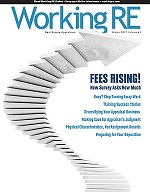 |
Services Offered this Issue
> The Appraiser Coach Podcast
|
> Join over 5,000 others. Take OREP/WRE’s 2017 Fee Survey Today!
Editor’s Note: The following is a question and answer from the CE course How to Support and Prove Your Adjustments (7 Hours) by Richard Hagar, SRA, offered through the OREP Education Network (OREP insureds enjoy discounted enrollment).
Appraiser Q&A- Supporting Adjustments
By Richard Hagar, SRA
Question:
Hi Richard. I have just finished your 7 hour online Adjustments course. It was a great help and I am still trying to get my head around some of it. :) I have been out of appraising for a while, and am just getting back into it, so I am very intrigued by what you are teaching because it was not necessarily the way I was initially taught. So, I have a question or two:
In video 11, you speak of grouped data and you give three illustrations of how to use it for finding a Location Adjustment and also for a 2 vs. 3 bedroom adjustment, etc. Many appraisers will not adjust for individual bedroom (room) count, but will instead adjust for the overall GLA. Do you see some reason to adjust for bedrooms for certain assignments (e.g. your example given here), and if so, do you also adjust for the GLA? And if you only adjust for one, then in what situation would you choose one adjustment over the other? Thanks so much for your time! – Dave
Answer from Course Instructor Richard Hagar
Good morning and good question! Square feet (SF) or Bedroom AND SF. To a degree it comes down to the amount and accuracy of the data. It used to be very common for us to make bedroom adjustments and then smaller SF adjustments. We now find that data supporting SF adjustments are stronger than that for making bedroom adjustments. I’d say that we ONLY adjust for SF 85% of the time and 15% of the time for SF and bedrooms. The change has come due to the amount and accuracy of the data today vs. the data from years ago.
In the past many appraisers used rule-of-thumb adjustments which often stated that SF and bedroom adjustments were the “thing.”
Now, with access to better data and the proper use of various methods, the old rules-of-thumb adjustments are just that….. old and outdated. I hope this helps and I’m glad you enjoyed the course!
This is a question and answer from the CE course How to Support and Prove Your Adjustments (7 Hours) by Richard Hagar, SRA.
> How To Support and Prove Your Adjustments
Presented by: Richard Hagar, SRA
CE Online – 7 Hours (approved in 40+ states)
Must-know business practices for all appraisers working today. Ensure proper support for your adjustments. Making defensible adjustments is the first step in becoming a “Tier One” appraiser, who earns more, enjoys the best assignments and suffers fewer snags and callbacks. Up your game, avoid time-consuming callbacks and earn approved CE today!
Sign Up Now! $119 (7 Hrs)
OREP Insured’s Price: $99

> How are Fees in Your Area? Weigh in today on OREP / Working RE’s 2017 Fee Survey.
Click here to take 2017 Fee Survey!
About the Author
Richard Hagar, SRA is an educator, author and owner of a busy appraisal office in the state of Washington. Hagar now offers his legendary adjustments course for CE credit in over 40 states through OREPEducation.org. The new 7-hour online CE course How to Support and Prove Your Adjustments shows appraisers proven methods for supporting adjustments. Learn how to improve the quality of your reports and defend your adjustments! OREP members save on this approved coursework. Sign up today at www.OREPEducation.org.
Send your story submission/idea to the Editor: isaac@orep.org


